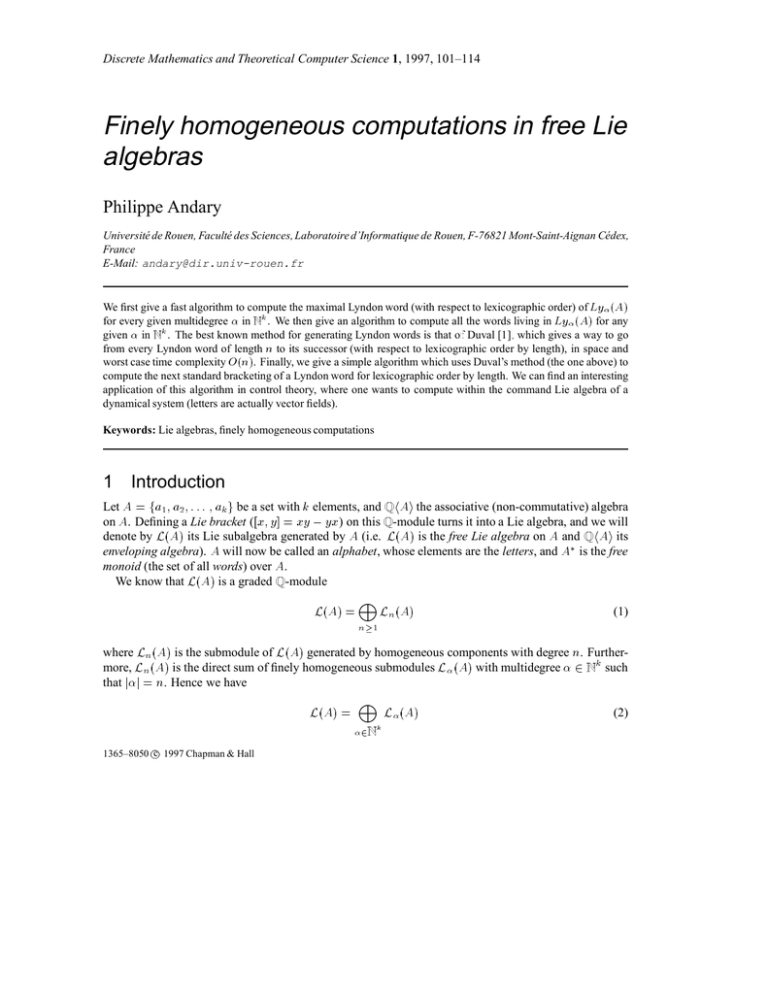Finely homogeneous computations in free Lie algebras Philippe Andary
advertisement

Discrete Mathematics and Theoretical Computer Science 1, 1997, 101–114
Finely homogeneous computations in free Lie
algebras
Philippe Andary
Université de Rouen, Faculté des Sciences, Laboratoire d’Informatique de Rouen, F-76821 Mont-Saint-Aignan Cédex,
France
E-Mail: andary@dir.univ-rouen.fr
We first give a fast algorithm to compute the maximal Lyndon word (with respect to lexicographic order) of Ly (A)
for every given multidegree in k . We then give an algorithm to compute all the words living in Ly (A) for any
given in k . The best known method for generating Lyndon words is that of Duval [1], which gives a way to go
from every Lyndon word of length n to its successor (with respect to lexicographic order by length), in space and
worst case time complexity O(n). Finally, we give a simple algorithm which uses Duval’s method (the one above) to
compute the next standard bracketing of a Lyndon word for lexicographic order by length. We can find an interesting
application of this algorithm in control theory, where one wants to compute within the command Lie algebra of a
dynamical system (letters are actually vector fields).
N
N
Keywords: Lie algebras, finely homogeneous computations
1 Introduction
Let A = fa1; a2; : : : ; akg be a set with k elements, and QhAi the associative (non-commutative) algebra
on A. Defining a Lie bracket ([x; y] = xy yx) on this Q-module turns it into a Lie algebra, and we will
denote by L(A) its Lie subalgebra generated by A (i.e. L(A) is the free Lie algebra on A and QhAi its
enveloping algebra). A will now be called an alphabet, whose elements are the letters, and A is the free
monoid (the set of all words) over A.
We know that L(A) is a graded Q-module
L(A) =
M
n1
Ln(A)
(1)
where Ln(A) is the submodule of L(A) generated by homogeneous components with degree n. Furthermore, Ln (A) is the direct sum of finely homogeneous submodules L (A) with multidegree 2 Nk such
that jj = n. Hence we have
L(A) =
1365–8050 c 1997 Chapman & Hall
M
2Nk
L(A)
(2)
102
Philippe Andary
All the classical monomial basis of L(A) are finely homogeneous (see Reutenauer [2], for example, or
Viennot [3]), i.e. their components are finely homogeneous Lie monomials, thus every computation on
Lie polynomials (the elements of L(A)) is nothing but a computation in some fine homogeneity class.
We want to emphasize the use of a particular basis of L(A), the Lyndon basis, introduced by Chen et
al. in the late 1950s [4] (the interested reader can find all the details of its construction in Lothaire [5]).
For this purpose, we choose a total order a1 < a2 < : : : < ak on A, which induces a lexicographic order
on A . A word ` is a Lyndon word if it is primitive and minimal in its conjuguacy class. This means that `
cannot be written as un for given u in A and n 2, and ` vu whenever ` = uv. We denote by Ly(A)
the set of Lyndon words over A.
For every Lyndon word ` we define its (right) standard factorization (`0 ; `00) as the unique couple of
Lyndon words such that ` = `0 `00 and `00 is of maximal length. Moreover, the recursive Lie bracketing of
the standard factorization will be called the (right) standard bracketing of `, denoted by [`].
It would be convenient to define the left standard factorization (u; v) of ` as the unique couple of
Lyndon words such that ` = uv and u is of maximal length. Then the recursive Lie bracketing of the left
standard factorization will be called the left standard bracketing of `, denoted by (`).
Note that A is included in Ly(A) and that [a] = a = (a) for every letter a. As an exemple, let
A = fa; bg and ` = aaabab, then ` is Lyndon because it is primitive and ` < s for each of its proper
suffix s. The standard bracketings of ` are
[`] = [a; [[a; [a; b]]; [a; b]]]
(`) = [[a; [a; [a; b]]];[a;b]]
It is well known that Ly(A) is a factorization of A and that [Ly(A)] is a basis of L(A) (called the Lyndon
basis of L(A)).
The paper is organized as follows. First, we give a fast algorithm to compute the maximal Lyndon
word (with respect to lexicographic order) of Ly (A) for every given multidegree in Nk . We will see
that the letters of a Lyndon word which is maximal in its fine homogeneity class are as much ‘regularly
distributed’ as possible.
In the second part, we give an algorithm to compute all the words living in Ly (A) for any given in
Nk . The best known method for generating Lyndon words is that of Duval [1], which gives a way to go
from every Lyndon word of length n to its successor (with respect to lexicographic order by length), in
space and worst case time complexity O(n). It is easy to see that in the special case where A = fa; bg and
` = ak+3 bak 1b (k > 0), there are 2k 1 1 Lyndon words of length 2k + 4 between ` and its successor
in the same fine homogeneity class (namely ak+2bak b). Hence, this method has an exponential worst case
time complexity for our purpose.
Finally, we give a simple algorithm which uses Duval’s method (the one above) to compute the next
standard bracketing of a Lyndon word for lexicographic order by length. We can find an interesting application of this algorithm in control theory, where one wants to compute within the command Lie algebra of
a dynamical system (letters actually are vector fields). Standard bracketing are very expansive to compute
in this context, and that is why we want to generate them as quickly as possible in the lexicographic order
by length.
Finely homogeneous computations in free Lie algebras
103
2 Maximal Finely Homogeneous Lyndon Words
2.1 Introduction
Given in (N )k , the question is to find a description of the maximal finely homogeneous Lyndon word
with respect to lexicographic order
(A) = maxfLy (A)g
(3)
We will merely denote it by when no confusion is possible.
Before answering our question, let us give a short description of the problem’s background. Let ` be a
Lyndon word with fine homogeneity 2 (N )k ; it is well known [5] that
[`] = ` +
X
`<w
w
(4)
Of course, if ` = the only Lyndon word appearing in [`] is ` itself, but the reciprocal may, or may not,
be true. Anyhow, this led us to an algorithmic answer to our former question, when A = fa; bg in a first
time, then for any finite alphabet. Just for fun now, we know that the reciprocal is not true and we were
able to find a lot of counter examples (with the help of computers) for which
supp([`]) \ Ly (A) = f`g
(5)
For example, each of the following words aabbabaabbabababaabbabab, aabbabababaabbababababab and
aabbabababababababababab are in Ly(12;12)(fa; bg) and verify equation (5).
2.2 The Binary Case
= 2, thus A = fa; bg. We have the following:
Theorem 1 Given any couple (n; m) of positive integers, the MFHLynd function below returns the maximal Lyndon word in Ly(n;m) (fa; bg) with respect to lexicographic order:
Let us consider the case k
function MFHLynd((n; m),fa; bg)
# Input : (n; m) is a couple of positive integers.
#
fa; bg is the alphabet.
# Output : maxfLy(n;m) (fa; bg)g.
begin
if (n = 1) or (m = 1)
then Return(anbm )
else if n m
then q := n div m
r := n mod m
if r = 0
then Return(aq+1 baq 1b(aq b)m 2 )
else Return(MFHLynd((r; m),fa; aqbg))
104
Philippe Andary
else
q := m div n
r := m mod n
if r = 0
then Return(abq 1abq+1 (abq )n 2)
else Return(MFHLynd((n r; r),fabq ; abq+1 g))
end
Proof. Let (n; m) be any couple of positive integers. We will denote by the result of the MFHLynd
function. As this algorithm is recursive, we denote by ni , mi and Ai the instances of formal parameters
during the i-th function call (n1 = n, m1 = m and A1 = fa; bg). Note that the algorithm will terminate
in a finite number of steps, say p, since through each step i the sum ni + mi will strictly decrease.
Furthermore, let us denote by i the word (ni ;mi ) at each stage i.
If p = 1 then n is a multiple of m, or m is a multiple of n, and we obviously have = 1 =
(n;m)(fa; bg).
So let us consider the case p > 1, i.e. either n = q1m + r1 with q1 1 and 0 < r1 < m, or
m = q1n + r1 with q1 1 and 0 < r1 < n. Then (n2 ; m2 ) is (r1; m) or (n r1; r1), depending on
the value of n and m, and A2 is fa; aq1 bg or fabq1 ; abq1+1 g accordingly. Of course, 2 1 because
Ly(A2 ) Ly(A1 ), and if we prove that
1 2 A2
(6)
the previous inequality turns to an equality. Now the end of the proof is trivial: we have
relation (6) implies
1 = 2 = : : : = p
= p , but
(7)
Finally, for the proof to be complete, we have to justify relation (6). For this purpose, we will first
suppose that n = q1m + r1 (thus A2 = fa; aq1 bg). We can write
1 = aq1 +"1 b : : :aq1 +"m b
(8)
and one can easily see that "1 = 1, "2 2 f0; 1g and q1 "i 1 for 3 i m (since 1 2
Ly(n;m) (fa; bg)). Next, the existence of h = minfi : "i < 0g would imply the existence of a Lyndon
word ` in Ly(n;m) (fa; bg) which would be greater than 1 . Indeed, let us write 1 = wv1v2 : : :vt , where
w = aq1 +1 b : : :aq1 +"h 1 baq1 x b (x = j"h j) and the vi ’s are defined by the left standard bracketing of 1
(1 ) = [[: : :[[(w); (v1)]; (v2)]; : : :]; (vt)]
(9)
Furthermore, we will consider
w0 = aq1 +1 b : : :aq1 +"h
w00 = aq1 x+1 b
1
1b
(10)
(11)
Some vi ’s are greater than w0, some are not, but they are all greater than w. So we can split those vi
between w and w0 in two words, and apply the same transformation as in w ! (w0 ; w00 ). Now construct
Finely homogeneous computations in free Lie algebras
105
a sequence of Lyndon words, with those vi that are greater than w0 on the one hand, and the splitted ones
(vi0 ; vi00 ) on the other. Then concatenating this reordered sequence will give us a new Lyndon word which
is greater than 1 (because the former begins with w0, and the latter with w). But this fact contradicts the
maximality of 1 , so h doesn’t exist.
Now, the second case m > n, m not a multiple of n, is not substantially different from the previous
one. Let us denote by A0 the alphabet A equipped with the reverse order b < a. Then ' : A ! A0
such that '(a) = b and '(b) = a extends to an isomorphism from A onto (A0 ) . Moreover, ' is order
preserving, and we have clearly
(n;m) (fa; bg) = '((m;n) (fa; bg)) e
(12)
2
where (u1 : : :uk )e= uk : : :u1 is the mirror image of the word u.
The analysis of this algorithm is trivial, since its recurrence tree is structurally equivalent to that of
Euclide’s algorithm for computing the greatest common divisor of n and m. So we have
Theorem 2 For given positive integers (n; m), the worst case time complexity for MFHLynd function is
O(log(max(n; m))).
Proof. See Knuth [6] for instance, Theorem 4.5.3-F and Corollary 4.5.3-L, p. 343.
2
2.3 The General Case
In a second time, we were able to generalize the function MFHLynd to any finite alphabet
following manner:
function MFHLynd(,A)
# Input : = (1; : : : ; k) is a k-tuple of positive integers.
#
A = fa1; : : : ; ak g is the (ordered) alphabet.
# Output : maxfLy (A)g.
begin
n := P1
m := ki=2 i
if (n = 1) or (m = 1)
k
2
then Return(an
1 ak : : :a2 )
else if n m
then q := n div m
r := n mod m
if r = 0
then if k = 2
else
then Return(aq1+1 a2 aq1 1a2 (aq1 a2)m 2 )
else Return(MFHLynd((2; : : : ; k ),faq1a2; : : : ; aq1ak g))
else Return(MFHLynd((r; 2; : : : ; k),fa1; aq1a2 ; : : : ; aq1ak g))
h := n
for i
decreasing from
k
downto
2
do
A in the
106
end
Philippe Andary
qi := i div h
ri := i mod h
h := h ri
if (8i; ri = 0)
then Return(a1aqkk : : :aq22 1a1 aqkk : : :aq22 +1 (a1 aqkk : : :aq22 )n 2)
else t := 0
for i increasing from 2 to k do
if ri > 0
then t := t + 1
it := i
Pt
Return(MFHLynd((n
: ; rit ),
j =1 rqij ; ri1 q; : :+1
i1 1 i1
q
q
q
k
2
k
fa1 ak : : :a2 ; a1ak : : :ai1 1 ai1 ; : : : ; a1aqkk : : :aqitit 11 aqitit +1 g))
We can reasonably expect the complexity of such an algorithm to be a function in the size of the alphabet
and in the maximum of the components i, but unfortunately, we were not able to analyse the behaviour
of MFHLynd function in this case deeply enough.
3 Fine Homogeneous Generation of Lyndon Words
3.1 Introduction
Now the problem is to find all words in Ly (A), for every in (N ) . We will need the following well
known reducing property (see, for example, Duchamp and Krob [7] for a partially commutative version
of this proposition):
k
> 1, A = fa1 < : : : < ak g and A0 = (A ak )ak . Then Ly(A) = Ly(A0 ) [ fak g.
Let us see, with an example, how we will dissect Lyndon words to solve our problem. Suppose =
(3; 3) and A = fa; bg (k = 2). By proposition 1, if A0 = ab then Ly(A) = Ly(A0 ) [ b. Denoting by B
the minimal subset of A0 such that Ly (A) B , we mean the code
Proposition 1 Let k
B = fa; ab; abb; abbbg
(13)
We want to find out all Lyndon words on B that are in Ly (A) ; we know their fine homogeneity, but we
don’t know how they look like: there can be either two a and one abbb, or one a, one ab and one abb.
(Note that we cannot take three times ab, since Lyndon words are primitive.)
Hence, our initial problem breaks down into two ‘smaller’ subproblems – find all of the words in
Ly(2;1)(fa; abbbg) and Ly(1;1;1)(fa; ab; abbg). These subproblems are smaller insofar as the length of
the involved Lyndon words are smaller over the new alphabets than over the previous one (here, we have
to compare fa; abbbg and fa; ab; abbg with fa; bg). It is still necessary to detail the way we compute
Ly(1;1;1)(fa; ab; abbg). Here we have = (1; 1; 1), A = fa; ab; abbg (k = 3) and B is the code
B = fa; aabb; ab; ababbg
(14)
Finely homogeneous computations in free Lie algebras
107
Every word in Ly (A) is a Lyndon word over B , with either one aabb and one ab, or one a and one ababb.
Thus
Ly(1;1;1)(fa; ab; abbg) = Ly(1;1)(faabb; abg) [ Ly(1;1)(fa; ababbg)
(15)
Clearly, iterating this process will give, in a finite number of steps, every Lyndon word on fa; bg with
fine homogeneity (3; 3). In fact, our algorithm will ultimately construct all alphabets with only one letter
which is a word in Ly(3;3) (fa; bg). For example, the subproblems’ decomposition tree in this case is
Ly(3;3)(fa; bg)
PPPP
)
Pq
Ly(2;1)(fa; abbbg)
Ly(1;1;1)(fa; ab; abbg)
HH
HHj
?
Ly(1;1)(fa; aabbbg)
Ly(1;1)(fa; ababbg)
Ly(1;1)(faabb; abg)
Ly(1) (faaabbbg)
Ly(1) (faababbg)
Ly(1) (faabbabg)
?
?
?
and finally, Ly(3;3) (fa; bg) = faaabbb; aababb; aabbabg.
3.2 Translation in Terms of Partition
Looking closely at our process gives the feeling that breaking down our problem into smaller ones is
exactly the same as finding a set of partitions under some constraints. For example, in the first stage of our
previous computation we have searched for the set of elements x in N4 such that x1 + x2 + x3 + x4 = 3,
verifying the constraint x1 + 2x2 + 3x3 + 4x4 = 6. We have accepted (2; 0; 0; 1) and (1; 1; 1; 0), refused
(0; 3; 0; 0) (since Lyndon words are primitive), and thereby found all the solutions in x. Next, during
2
the decomposition of Ly(1;1;1)(fa; ab; abbg), we have searched for the set of elements (x; x0) in N2
verifying
x1 + x2 = 1
x01 + x02 = 1
x1 + 2x2 + x01 + 2x02 = 3
Here, again, we have found all the solutions in (x; x0), namely ((1; 0); (0; 1)) and ((0; 1); (1; 0)).
For a good formulation of the problem in terms of composition and partition, we will need some notations and definitions. For every x in Np , we define
jxj = x1 + x2 + : : : + xp
(16)
jjxjj = x1 + 2x2 + : : : + pxp
(17)
and
108
Philippe Andary
A composition of the positive integer n into p parts is a p-tuple x in Np such that jxj = n. Furthermore,
when jjxjj = n + we say that x is constrained by . We will denote by (n; p) (resp. (n; p)) the set
of all compositions of n into p parts (resp. the set of all compositions constrained by ).
A partition of the positive integer n into p parts is a p-tuple y in (N )p such that jyj = n and y1 : : : yp 1. We will denote by (n; p) the set of all partitions of n into p parts, and by (n; p) the set
of all partitions of n into p parts whose value does not exceed (thus y1 ).
For consistency with our previous notations, we will call x
= (xi1 ; : : : ; xit ) the composition x without
any 0’s (thus, for all 1 j t, xij > 0 and every other xi are zero), and we will denote by Bx the subset
of elements of B at the ij -th place for lexicographic order (1 j t).
Here is a trivial property which will be helpful for computing the compositions, since we know a
constant worst case time complexity algorithm to derive the successor of a partition (see Nijenhuis and
Wilf [8]).
Proposition 2 For given n, p and , every partition in p(n+; n) is equivalent to a unique composition
in (n; p).
Proof. The proof is immediate if we see that, given a partition y in p(n + ; n), the corresponding
composition x in (n; p) is such that xi is nothing but the number of parts (in y) equal to i (for all i in
[1; p]).
2
As an example, all the compositions constrained by 3, of 3 into no more than 4 parts are (2; 0; 0; 1),
(1; 1; 1; 0) and (0; 3; 0; 0). Proposition 2 says that they are equivalent to the partitions of 6 into 3 parts not
greater than 4, namely (4; 1; 1), (3; 2; 1) and (2; 2; 2); which will become evident with the notation 12 4,
123 and 23 . For every partition y in this last form, which is equivalent to a composition x, we will write
y the sequence of non zero exponents (for example, if y = 123 then y = (1; 1; 1)); so that x = y.
3.3 The Algorithm
Now we can state
> 1, A = fa1 < : : : < ak g and = (1; : : : ; k ) 2 (N )k . Set B := fai ak j : 1 i k 1; 0 j k g, := (k ; k) and for each in :
Theorem 3 Let k
X := 1 (1 ; k + 1) : : : k 1 (k 1; k + 1):
Then we have
Ly (A) =
[ [
2 x2X
Lyx (B)
(18)
Proof. On the one hand, we will study the case k = 2, so we consider A = fa; bg, = (n; m) and
There is m + 1 elements in B , and to each composition x 2 Nm+1 , we
associate the fine homogeneous class of words in B B = fabj : 0 j mg.
Fx = fw 2 B : jwjabj = xj ; 0 j mg:
(19)
Since Fx is never empty, there is at least one Lyndon word in Fx (note that, by Proposition 1, Ly(B) Ly(A)) and we want to determine those x such that Fx contains a Lyndon word in Ly (A) – thus every
Finely homogeneous computations in free Lie algebras
109
Lyndon word in Fx will belong to Ly (A). Of course, Ly (A) will be the union set of Lyx (B) over all
these x. But it is clear that the only criteria for x 2 Nm+1 to be choosen are jxj = n and jjxjj = n + m.
So x must be a composition of n into no more than m + 1 parts, constrained by m, and the theorem is
proved when k = 2 (with = f(m)g and X(m) = m (n; m + 1)).
On the other hand, we will now consider the case k > 2. Then we have B = faiak j : 1 i k 1; 0 j k g and jB j = k(k + 1). Here, the problem is to find all x = (x(1) ; : : : ; x(k 1)) in
Nk+1 k 1 such that
jx(i)j
1 jjx(i)jj
i=1
Pk
Thus we must have, for all i, the inequalities
= i (1 i k 1)
= jj
i jjx(i)jj i + k
and it is clear now that the set of solutions for system (20) is exactly the union set over the jB j-tuple x of (non-negative) integers verifying
for all 1 i k
1.
jx(i)j = i
jjx(i)jj = i + i
(20)
(21)
2 (k ; k) of
(22)
2
From Theorem 3 and Proposition 2, we can deduce the function FHGLynd, which takes as input an
alphabet A and a multidegree , and outputs the set of elements in Ly (A)
function FHGLynd(,A)
# Input : = (1; : : : ; k) is a k-tuple of positive integers.
#
A = fa1; : : : ; ak g is the (ordered) alphabet.
# Output : Ly (A).
begin
if (k = 2) and ((1 = 1) or (2 = 1))
1 2
then Return(fa
1 a2 g)
j
else B := fai ak : 1 i k 1; 0 j k g
XPhi := fg
Lyn := fg
for in (k ; k) do
X := k+1 (1 + 1; 1)
for i increasing from 2 to k 1
X := X k+1 (i + i; i)
XPhi := XPhi [ X
for x in XPhi do
Lyn := Lyn [ FHGLynd(x; Bx )
Return(Lyn)
end
do
110
Philippe Andary
3.4 Tests on the Execution Time
Except for the FHGLynd function, the only algorithm at hand for computing the homogeneity class of
Lyndon words could be one derived from Duval’s method. As we will see in the next section, this method
allows us to go from one Lyndon word to the (lexicographically) next one with the same length. Thus, a
new function, say FHGL, is born: given an alphabet A with k letters and a homogeneity vector (with
n = jj), construct the set Ly (A) by iterative application of Duval’s method, picking up those words
whose homogeneity is . However, we have to bear in mind that this is an exponential algorithm, since
n
the number of Lyndon words whose length is n is O( kn ). We wanted to get a feeling on the complexities
of both methods. For this purpose, both algorithms have been implemented in Maple V.3 on an SS10
workstation under Solaris 2.3 operating system.
The first time we found out that, for the generation of a given homogeneity class of Lyndon words, the
FHGLynd function is more efficient than FHGL.
The second time, we decided, given a finite alphabet A of size k and an integer n, to generate all the
words in Lyn (A), first in lexicographic order by Duval’s method (algorithm D), and then by homogeneity
classes with our function (algorithm A). Although the average running time of A per homogeneity class
becomes gradually smaller than the running time of D while k and/or n grow, algorithm A does not seem
to be linear in n, since algorithm D does, and their execution time ratio increases.
Hence, it is obvious that these two algorithms are devoted to different problems: FHGL is well suited for
lexicographic enumeration of Lyndon words of given length, while FHGLynd is just right for homogeneity
generation of Lyndon words.
4 Generating the Lyndon Basis
4.1 Introduction
We want here to generate the standard bracketing of Lyndon words for lexicographic order by length. We
know an efficient algorithm, due to Duval [1], which gives the next Lyndon word for lexicographic order
by length with a constant average time complexity [9]. The idea is quite simple: adapt Duval’s method
to obtain the index of the standard factorization in addition to the Lyndon word, of course, preserving
time complexity; then a convenient tree data structure could be used to recursively store all the standard
factorizations.
4.2 Duval’s Theorem
We will write ‘’ and ‘’ for lexicographic order and lexicographic order by length, respectively. These
total orders on A are defined as follows:
uv
uv
8
<
iff
:
or
8
<
iff
:
or
v 2 uA ;
(9r; s; t 2 A )(9a; b 2 A)(u = ras; v = rbt; a < b)
juj < jvj;
juj = jvj; u v
For all Lyndon word `, we will denote by S(`), when it makes sense, its successor, for lexicographic
order, which is not in `A . It is computed as follows: remove all terminal maximal letters of `, then
Finely homogeneous computations in free Lie algebras
111
replace the last non-maximal letter by its successor in A. Notice that S(`) has always a smaller size than
`. For example, on A = fa; b; cg, S(aaacc) is aab (not aabab !), and S(aaabb) is aaabc. Duval proves
that
Theorem 4 If ` is a Lyndon word with length n, which is not maximal in its fine homogeneous class ; if
w is the following Lyndon word of ` for ‘’, then we have:
w=
S(`)
u1 q1 : : :ut qt
if jS(`)j = n
otherwise
(23)
where the ui are Lyndon words derived from prefixes of `.
More precisely, the ui are defined as follows (where u[1::j] is the prefix of u, whose length is j ):
u1 = S(`);
d1 = ju1j; q1 = (n 1) div d1; r1 = 1 + (n 1) mod d1;
u2 = S(u1 [1::r1]); d2 = ju2j; q2 = r1 div d2;
r2 = r1 mod d2 > 0;
:::
ut = S(u1 [1::rt 1]); dt = jutj; qt = rt 1 div dt;
rt = rt 1 mod dt = 0:
Let us have a feeling on the behaviour of the underlying algorithm on the Lyndon word ` = a3bab10
(over A = fa; bg). The first prefix we compute is (a3b2 )2, since S(`) = a3b2 , and because r1 must
be positive. Then we get (a3 b2)2 a2b since S(a3 b2) = a2b, and finally, we compute S(a2 ) = ab giving
w = (a3b2 )2 a2bab.
This algorithm is O(j`j) in worst case time complexity, and Berstel and Pocchiola [9] have proved it to
be optimal in average time complexity (actually, they give the asymptotic bound (k + 1)=k, where k is
the cardinal of A).
4.3 Adapted Duval’s Algorithm
We have seen that Duval constructs the next Lyndon word by computing successive prefixes, thus we had
the natural idea to use the left standard factorization instead of the right one, as usual. So, if we denote by
i(u) the index of the left standard factorization of a Lyndon word u, and with the notations of Theorem 4,
we have
Theorem 5 If w = S(`), then i(w)
u1q1 : : : utqt and i(w) = n dt.
= i(`) ;
otherwise if
w = u1 q1 u2 , then i(w) = d1, else w =
Proof. First, we have to notice that, for all 1 < i t, the relation ui = S(u1 [1::ri 1]) implies the
existence of the integer di in [[1; ri 1]] and the letter i = succ(ui 1 [di]) such that (set u0 = `)
ui = ui 1[1::di 1]i
(24)
So we have
di ri 1
|
|
|
|
{z
ui
di 1 ri 2
d1
}
{z
ui 1
:: ::
}
{z
u1
}
{z
`
}
112
Philippe Andary
where grayed zones means the suppression of maximal letters.
Now we can carry through the proof. If w = S(`) this is because jS(`)j = n, that is S(`) =
`1 : : : `n 1succ(`n ) with `n < z . In this case i(w) is obviously i(`).
Otherwise, there are two cases left. On the one hand, when w = u1 q1 u2 we must have i(w) =
d1 because of the preliminary remark. On the other hand, in the general case (t > 2, or t = 2 and
q2 > 1), the longest prefix of w which is Lyndon, is at least as long as u1q1 : : :ut 1qt 1 utqt 1 , since
u1 < u2P<t : :1 : < ut. But according to the preliminary remark, it cannot be longer than this word. Hence
i(w) = i=1 qidi + (qt 1)dt = n dt.
2
As an example, let us consider A = fa; bg and n = 5. Then we have the following table:
(`; i(`)) w = u1 q1 : : :utqt i(w)
(aaaab; 1)
(aaab)(b)
4
(aaabb; 4)
(aab)(ab)
3
(aabab; 3)
(aabb)(b)
4
(aabbb; 4)
(ab)2(b)
2
(ababb; 2)
(abb)(b)2
4
for the four first lines i(w) is d1, since t = 2 and q2 = 1, but for the fifth it is n d2 = 4 since q2 > 1.
Now, for the sake of completeness, let us give the slight improvement of Duval’s algorithm
function NextLynd(`,i(`))
# Input : ` is a Lyndon word which is not maximal in its fine
#
homogeneous class.
#
i(`) is the index of the standard factorization of `.
# Output : w, the successor of ` with same length, for lexicogra#
phic order by length ; or the empty word if ` is maximal
#
in its fine homogeneous class.
#
i(w), the index of the standard factorization of w ;
#
or 0 if ` is maximal in its fine homogeneous class.
begin
let z be the maximal letter of A for lexicographic order
n := j`j
w := `
k := n
w[k] = z do
k := k 1
w[k] := succ(w[k])
if w[1] = z
then Return(",0)
else t := 1
while
Finely homogeneous computations in free Lie algebras
113
i := 0
d1 := k
k < n d1 do
for j increasing from 1 to d1 do
w[k + j] := w[j]
k := k + d1
while k 6= n do
t := t + 1
i := k
for j increasing from 1 to n k do
w[k + j] := w[j]
k := n
while w[k] = z do
k := k 1
w[k] := succ(w[k])
dt := k i
if t = 2
then q2 := 1
while k n d2 do
for j increasing from 1
w[k + j] := w[i + j]
k := k + d2
q2 := q2 + 1
else while k n dt do
for j increasing from 1
w[k + j] := w[i + j]
k := k + dt
if t = 1
then Return(w,i(`))
else if t = 2 and q2 = 1
then Return(w,d1)
else Return(w,n dt)
while
to
d2
do
to
dt
do
end
where u[j] means the j th letter of u, and succ() is the following letter of in A.
It is clear that the complexity is the same as for the original algorithm, since we have added only two
tests in the function’s body (and also the use of four new integer variables).
References
[1] Duval, J.-P. (1988). Génération d’une section des classes de conjuguaison et arbre des mots de Lyndon
de longueur bornée. Theor. Comput. Sci. 60, 255–283.
114
Philippe Andary
[2] Reutenauer, C. (1993). Free Lie Algebras. London Mathematical Society Monographs, new series,
Vol. 7. Academic Press.
[3] Viennot, X. G. (1978). Algèbres de Lie libres et monoı̈des libres. Lecture Notes in Mathematics 691.
Springer-Verlag.
[4] Chen, K. T., Fox, R. H. and Lyndon, R. C. (1958). Free differential calculus, IV. The quotient groups
of the lower central series. Ann. Mathematics 68, 81–95.
[5] Lothaire, M. (1983). Combinatorics on words. Encyclopedia of Mathematics 17. Addison-Wesley.
[6] Knuth, D. E. (1981). The Art of Computer Programming, vol. 2: Semi-numerical algorithms (2nd ed.)
Addison-Wesley.
[7] Duchamp, G. and Krob, D. (1994). Combinatorics in trace monoids II. In: Diekert and Rozenberg,
editors, The Book of Traces.
[8] Nijenhuis, A. and Wilf, H. S. (1975). Combinatorial Algorithms. Academic Press.
[9] Berstel, J. and Pocchiola, M. (1992). Average cost of Duval’s algorithm for generating Lyndon words.
Preprint no. 92-8, Laboratoire d’Informatique de l’Ecole Normale Supérieure, Paris.








